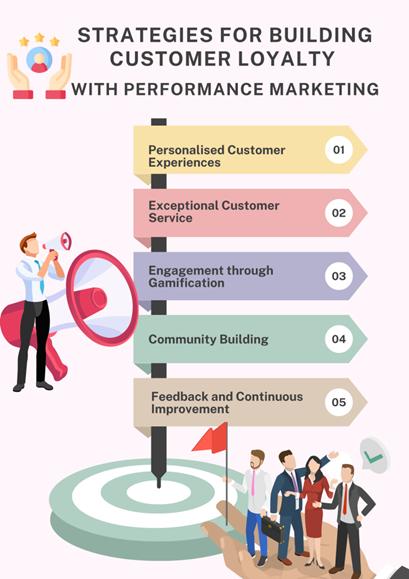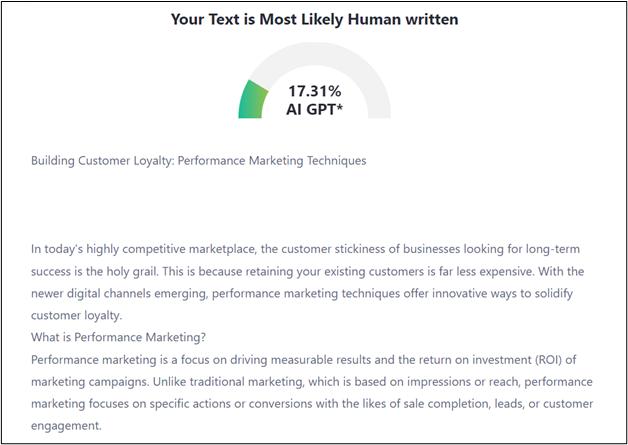Building Customer Loyalty: Performance Marketing Techniques

In today’s highly ahead-of-the-crowd marketplace, attaining (and retaining) customer loyalty is necessary for long-term success. This is because retaining your existing customers is far less expensive than it used to be. With newer video channels emerging, performance marketing offers fresh modalities to solidify customer loyalty.
What is Performance Marketing?
Performance marketing maximising the return on investment (ROI) of marketing campaigns. Unlike long-established and accepted marketing, which is derived from impressions or reach, performance marketing focuses on specific actions or conversions with the likes of sale completion, leads, or customer engagement.
Basically, performance marketing is a analytics based kind of approach, and the campaigns get highly optimised with the ability to track most metrics to increase performance. It comprises performance marketing, which includes affiliate marketing, influencer marketing, content marketing, and search engine marketing (SEM).
Building customer loyalty through performance marketing techniques is necessary for businesses seeking enduring growth and long-term success. For category-defining resource, TIDAL Video understands real meaning from connecting with customers on a further level to encourage lasting relationships.
With this, the business organisations have a clear vision that the marketing effort applied by the business organisation is paid off and can be contributed toward the business aim.
Impacts of Performance Marketing Strategies
Here are some pivotal business benefits that arise from performance marketing strategies aiming to strengthen customer loyalty.
- Measurable Results: Performance marketing built-inly has a full sum of data. It allows companies to approximate measurements of success from exact campaign execution and initiatives. This visibility into metrics, such as customer acquisition costs, conversion rates, or return on investment, guides you in making informed decisions and optimisations.
- Cost-Punch: By focusing on measurable actions and conversions, performance marketing ensures that marketing budgets are allocated effectively. Businesses only pay for desired outcomes, such as sales or leads, rather than impressions or clicks, resulting in higher ROI.
- Pinpoint Audience Reach: Other performance marketing tactics include influencer marketing, affiliate partnerships, and pinpoint advertising among the lots. Such marketing tactics are to support businesses to reach an intended specific part of the audience, which is most likely to convert into loyal customers. Such an approach is pinpoint to maximise the punch of marketing efforts although minimising wastage.
- Highly Personalised Experiences: Performance marketing enables businesses to ensure they produce a very high level of personalised experience reflecting customers’ individual preferences and behaviours through the utilisation of customer data and analytics. This level of personalisation again creates more opportunities for customer satisfaction and loyalty.
- Scalability and Flexibility: Being expandable , all marketing strategies under performance can easily adjust themselves according to the business requirements and objectives. About this, campaigns could be adjusted or optimised very fast, considering real-time information that justifies marketing efforts to be agile and responsive.
- Continuous Improvement: The very nature of performance marketing is evidence-based with the ability to continuously test, experiment, and optimise at their grace. Areas that need improvement are identified, and from there, the development of business strategies is honed to give better outcomes over time.
Ahead-of-the-crowd Advantage: Performance marketing approaches, if act employing the latest technologies and methodologies with precision, can promise businesses an added advantage in the ahead-of-the-crowd marketplace. This could be translated into greater customer loyalty, market share, and so, long-term success.
Core Strategies for Building Customer Loyalty Through Performance Marketing

1. Personalised Customer Experiences
Personalisation is the pivotal to nabbing and keeping customer attention in such an oversaturated market. If it is so, part the customer list derived from shopping history and behaviour. This way, it would improve significance focusing on, giving a sense of exclusivity to customers.
“Personalisation is no longer a luxury or an add-on; it is what firms will need to compete and deliver great customer experiences.” –
That’s not all; when you decide to use customer data to personalise interaction through various touch points boosts engagement although making sure marketing communications are timely and on-point. From personalised product recommendations to email campaigns, this approach helps take customers through a smooth and delightful experience.
2. Overwhelmingly rare Customer Service
Although new customers are basic and urgent to acquire, it should not happen at the cost of losing old customers. Striking customer service supports customer loyalty since it ensures trust and renews the brand’s commitment to customer satisfaction. This shows how the respective businesses should target a strong, constructive experience for the clientele by placing a lot of emphasis on striking customer service through the many channels.
One of the mainstays of excellent customer service has been the implementation of omnichannel support strategies with the broadest function.
The approach ensures that customers get an experience in every channel that is effortlessly integrated connected to the approach of one-on-one, phone conversation, email, or even social media. This has the effect of businesses being able to serve customers with different preferences of how they prefer to receive their support and results, which is satisfied customers.
3. Engagement through Gamification
Gamification rises among strong tools in the performance marketing arsenal, turning the most commonplace transactions into engrossing, entertaining, and rewarding experiences. By adding elements of games, including points, badges, leaderboards, and obstacles, companies have an opportunity to drive a sense of achievement and loyalty among customers.
A performing marketing agency will be able to assist in the enforcement of these techniques, development of credible messages, optimisation of the advertising channels, and measuring the campaign performance that will have the most lasting results.
This strategy of gamification can be applied in very different modalities, from loyalty programme in which customers get points or rewards from the frequency of their purchases or range to mere engagement with the brand. This may take the formulary of a tiered reward system that spurs repeat business and encourages the customer to earn although deepening his relationship with the brand.
The result? Add some made appropriate through game mechanics marketing campaigns and social media contests into the mix, and you have a recipe for increased engagement and built loyalty through fun and friendly competition.
4. Community Building
Building a strong community around a brand is a powerful strategy for boosting customer loyalty. It’s used to create a strong community around the brand. Businesses use social media platforms, forums, and in-person events to create an opportunity for their customers to connect, share their experiences, and interact with like-minded people.
Encouraging user-generated content and customer interaction supports community ties and contributes to brand loyalty. Customers, when they feel part of a community that shares values and interests, are likely to stay firm on the bandwagon and become strong advocates of the products or services offered by the brand.
5. Feedback and Continuous Improvement
Customer feedback is an very useful endowment for businesses seeking to improve their products, services, and when you really think about it customer experience. By also each week collecting and acting on customer feedback, businesses show their commitment to continuous improvement and customer satisfaction.
Implementing customer feedback mechanisms, such as surveys, direct transmission channels, and social media observing advancement, provides businesses with useful discoveries into customer preferences, pain points, and areas for improvement. By adapting and building matching customer expectations, businesses can stay leading the trend and keep a loyal customer base.
Juxtaposition Table: Loyalty Programme Types and Features
| Loyalty programme Type |
Points-Based |
Tiered Rewards |
Made appropriate through game mechanics |
| Rewards Structure | Earn points for purchases/actions | Multiple reward levels based on spending/engagement | Badges, leaderboards, challenges |
| Customer Engagement | Moderate | High | High |
| Customer Retention | Moderate | High | High |
| Implementation Cost | Low to Moderate | Moderate | High |
| Personalisation | Moderate | High | High |
| Data Collection | Moderate | High | High |
This juxtaposition table provides our inquiry of different loyalty programme types and their pivotal features, allowing businesses to evaluate and choose the approach that aligns best with their goals and resources.
Building Customer Loyalty
The new time in building customer loyalty demands a tactical method that plays a mix of personalisation, excellent customer service, customer engagement with gamification, community building, and continuous improvement derived from customers’ feedback. Performance marketing techniques help businesses to create great customer experiences that would inspire customers to become loyal and advocates of the business.
In that case, customer loyalty is an continuing vistas. Businesses should continue progressing new strategies and modelling the old ones to remain matching the constantly-progressing dynamics of customer expectations. Adopt the said performance marketing strategies, and you will be on the way toward building a loyal customer base that drives the long-term success of the business.
Ready to deepen your customer loyalty? Work with a team of Performance Marketing experts to develop a strategy that will make your consumers become lifelong brand advocates.
Our Editing Team is Still asking these Questions
1. What are the most effective loyalty programmes to keep customers?
Though there is no uniform prescription for made appropriate through game mechanics tiered rewards. But, a loyalty programme surely goes a long way in influencing customer retention effectively. Tiered reward programmes offer a multitude of reward levels derived from either spending or engagement, so they motivate the customer to remain loyal to them and increase his interaction with the brand. Also, when gamifying the loyalty programmes, badges, leaderboards, and obstacles introduce features to encourage a fun and rewarding experience that drives continuous patronage.
2. How can small businesses carry out gamification into their strategies?
Even if small businesses introduce gamification in their marketing strategies, they would need an infusion of not many investments. Gamify small business marketing strategies with basic tactics, such as giving out video badges or points to customers for participation on social media, referrals, contest participation, and many more. This will give your customers a sense of achievement and loyalty towards your brand. Besides, it will easily afford deriving made appropriate through game mechanics experiences if gamification platforms or plugins are used.
3. What role does technology play in improving customer loyalty programmes?
Video tools and platforms easily confirm the firm to track customers’ behaviour, preferences, and so purchase history although giving out personalised offers and experiences. The same technology also enables much ease in customer service employing chatbots, self-service portals, and omnichannel support, among others, so making sure high customer satisfaction and company loyalty. Customer Relationship Management (CRM) Systems and Data Analytics confirm businesses to get the most out of their customer loyalty programmes with added intelligence.
